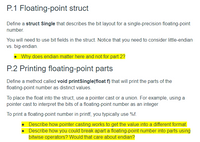
Computer Networking: A Top-Down Approach (7th Edition)
7th Edition
ISBN: 9780133594140
Author: James Kurose, Keith Ross
Publisher: PEARSON
expand_more
expand_more
format_list_bulleted
Question
The code I have given is the code that was required for these sections Which I have finished
I just need help with the highlighted bullet points sections so what I really need help with is understanding why I had to do the code in this way
#include <stdio.h>
struct Single
{
int num;
};
void printSingle(int f)
{
int binaryNum[33];
int i = 0;
while(f>0)
{
binaryNum[i] = f % 2;
f = f/2;
i++;
}
for (int j=i-1; j>= 0; j--)
{
printf("%d",binaryNum[j]);
}
}
int main()
{
struct Single single;
single.num = 33;
printf("Number: %d\n",single.num);
printSingle(single.num);
return 0;
}

Transcribed Image Text:P.1 Floating-point struct
Define a struct Single that describes the bit layout for a single-precision floating-point
number.
You will need to use bit fields in the struct. Notice that you need to consider little-endian
vs. big-endian.
Why does endian matter here and not for part 2?
P.2 Printing floating-point parts
Define a method called void printSingle(float f) that will print the parts of the
floating-point number as distinct values.
To place the float into the struct, use a pointer cast or a union. For example, using a
pointer cast to interpret the bits of a floating-point number as an integer
To print a floating-point number in printf, you typically use %f.
• Describe how pointer casting works to get the value into a different format.
Describe how you could break apart a floating-point number into parts using
bitwise operators? Would that care about endian?
Expert Solution
This question has been solved!
Explore an expertly crafted, step-by-step solution for a thorough understanding of key concepts.
Step by stepSolved in 2 steps

Knowledge Booster
Similar questions
- The code I have given is the code that was required for these sections Which I have finished I just need help with the highlighted bullet points sections so what I really need help with is understanding why I had to do the code in this way #include <stdio.h> struct Single { int num; }; void printSingle(int f) { int binaryNum[33]; int i = 0; while(f>0) { binaryNum[i] = f % 2; f = f/2; i++; } for (int j=i-1; j>= 0; j--) { printf("%d",binaryNum[j]); } } int main() { struct Single single; single.num = 33; printf("Number: %d\n",single.num); printSingle(single.num); return 0; }arrow_forwardplease anser the practice assgnment questions in th images attached. please leave your answer in C++ code ONLYarrow_forwardCode with comments and output screenshot is must. Thank you!arrow_forward
arrow_back_ios
arrow_forward_ios
Recommended textbooks for you
 Computer Networking: A Top-Down Approach (7th Edi...Computer EngineeringISBN:9780133594140Author:James Kurose, Keith RossPublisher:PEARSON
Computer Networking: A Top-Down Approach (7th Edi...Computer EngineeringISBN:9780133594140Author:James Kurose, Keith RossPublisher:PEARSON Computer Organization and Design MIPS Edition, Fi...Computer EngineeringISBN:9780124077263Author:David A. Patterson, John L. HennessyPublisher:Elsevier Science
Computer Organization and Design MIPS Edition, Fi...Computer EngineeringISBN:9780124077263Author:David A. Patterson, John L. HennessyPublisher:Elsevier Science Network+ Guide to Networks (MindTap Course List)Computer EngineeringISBN:9781337569330Author:Jill West, Tamara Dean, Jean AndrewsPublisher:Cengage Learning
Network+ Guide to Networks (MindTap Course List)Computer EngineeringISBN:9781337569330Author:Jill West, Tamara Dean, Jean AndrewsPublisher:Cengage Learning Concepts of Database ManagementComputer EngineeringISBN:9781337093422Author:Joy L. Starks, Philip J. Pratt, Mary Z. LastPublisher:Cengage Learning
Concepts of Database ManagementComputer EngineeringISBN:9781337093422Author:Joy L. Starks, Philip J. Pratt, Mary Z. LastPublisher:Cengage Learning Prelude to ProgrammingComputer EngineeringISBN:9780133750423Author:VENIT, StewartPublisher:Pearson Education
Prelude to ProgrammingComputer EngineeringISBN:9780133750423Author:VENIT, StewartPublisher:Pearson Education Sc Business Data Communications and Networking, T...Computer EngineeringISBN:9781119368830Author:FITZGERALDPublisher:WILEY
Sc Business Data Communications and Networking, T...Computer EngineeringISBN:9781119368830Author:FITZGERALDPublisher:WILEY

Computer Networking: A Top-Down Approach (7th Edi...
Computer Engineering
ISBN:9780133594140
Author:James Kurose, Keith Ross
Publisher:PEARSON

Computer Organization and Design MIPS Edition, Fi...
Computer Engineering
ISBN:9780124077263
Author:David A. Patterson, John L. Hennessy
Publisher:Elsevier Science

Network+ Guide to Networks (MindTap Course List)
Computer Engineering
ISBN:9781337569330
Author:Jill West, Tamara Dean, Jean Andrews
Publisher:Cengage Learning

Concepts of Database Management
Computer Engineering
ISBN:9781337093422
Author:Joy L. Starks, Philip J. Pratt, Mary Z. Last
Publisher:Cengage Learning

Prelude to Programming
Computer Engineering
ISBN:9780133750423
Author:VENIT, Stewart
Publisher:Pearson Education

Sc Business Data Communications and Networking, T...
Computer Engineering
ISBN:9781119368830
Author:FITZGERALD
Publisher:WILEY